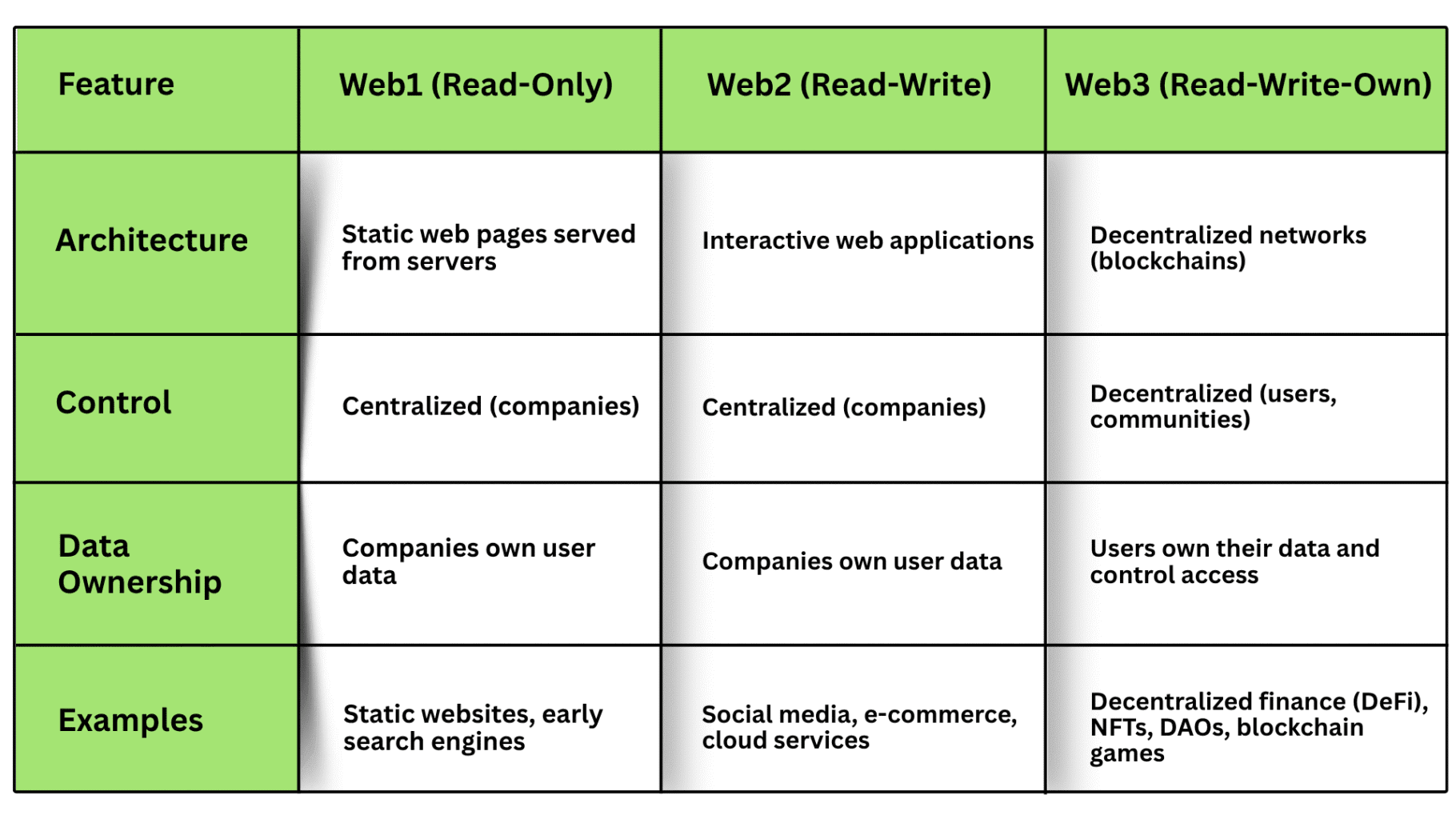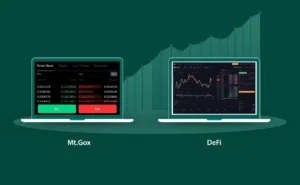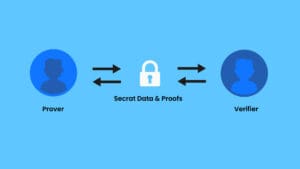
Introduction to Web3
Web3 represents the next evolution of the internet, built upon the principles of decentralization, transparency, and user empowerment. It shifts power away from centralized entities like Google, Facebook, and Amazon towards individual users and communities. Understanding Web3 requires grasping its core concepts and technologies. This guide will take you from the basics to advanced topics.
What is Web3?
- Decentralization– Web3 applications (“dApps”) operate on decentralized networks like blockchains, distributing data across many computers rather than a single server. This makes them more resilient to censorship and single points of failure.
- Blockchain Technology– The foundation of Web3. Blockchains are distributed, immutable ledgers that record transactions publicly and securely.
- Cryptocurrencies– Digital currencies that use cryptography for security and operate independently of central banks. They are often used to incentivize participation in Web3 networks.
- Non-Fungible Tokens (NFTs)– Unique digital assets that represent ownership of items, such as art, collectibles, or virtual land.
- Smart Contracts– Self-executing contracts written in code and stored on the blockchain. They automate agreements and enforce rules without intermediaries.
Key Differences Between Web1, Web2, and Web3

Core Technologies of Web3
Blockchain Basics
A blockchain is a chain of blocks, where each block contains a set of transactions and a cryptographic hash of the previous block. This creates an immutable and transparent record of all transactions.
- Blocks– Contain transaction data, a timestamp, and a hash of the previous block.
- Transactions– Represent the transfer of value or data on the blockchain.
- Hashing– A cryptographic function that converts data into a fixed-size string of characters. Even a small change in the input data results in a drastically different hash. This ensures data integrity.
- Consensus Mechanisms– Algorithms that ensure all nodes in the network agree on the state of the blockchain. Common examples include:
- Proof-of-Work (PoW)– Requires miners to solve complex computational puzzles to validate transactions and add new blocks. Energy intensive. (e.g., Bitcoin)
- Proof-of-Stake (PoS)– Allows validators to stake their cryptocurrency to secure the network and earn rewards. More energy-efficient than PoW. (e.g., Ethereum (post-Merge), Cardano)
- Delegated Proof-of-Stake (DPoS)– Similar to PoS, but token holders vote for delegates who validate transactions.
Smart Contracts
Smart contracts are programs stored on a blockchain that automatically execute when predefined conditions are met. They automate agreements and eliminate the need for intermediaries.
- Functionality– Automate tasks such as transferring funds, verifying identities, and managing supply chains.
- Immutability– Once deployed, smart contracts cannot be changed.
- Transparency– The code of smart contracts is publicly visible on the blockchain.
- Programming Languages– Solidity (Ethereum), Rust (Solana), Go (Cosmos).
Example (Solidity):
solidity
pragma solidity ^0.8.0;
contract SimpleStorage {
uint256 storedData;
function set(uint256 x) public {
storedData = x;
}
function get() public view returns (uint256) {
return storedData;
}
}Decentralized Storage
Decentralized storage solutions distribute data across multiple nodes, making it more resilient to censorship and data loss than traditional centralized storage.
- IPFS (InterPlanetary File System)– A peer-to-peer protocol for storing and sharing data in a decentralized manner.
- Filecoin– A decentralized storage network that incentivizes users to provide storage space.
- Arweave– A permanent data storage network that stores data indefinitely.
Oracles
Oracles bridge the gap between blockchains and the real world by providing external data to smart contracts. Blockchains themselves have no inherent access to off-chain data.
- Functionality– Supply smart contracts with data such as price feeds, weather information, and event outcomes.
- Centralized Oracles– A single source provides data. Introduces a single point of failure.
- Decentralized Oracles– Multiple sources provide data, increasing reliability and reducing the risk of manipulation. (e.g., Chainlink)
Decentralized Applications (dApps)
dApps are applications that run on decentralized networks, leveraging blockchain technology, smart contracts, and decentralized storage.
dApp Architecture
- Frontend– The user interface of the dApp, typically built with web technologies like React, Vue.js, or Angular. Interacts with the smart contract via a Web3 provider (e.g., MetaMask).
- Smart Contract– The backend logic of the dApp, written in a blockchain-specific language (e.g., Solidity). Deployed on a blockchain (e.g., Ethereum).
- Blockchain– The decentralized ledger that stores the dApp’s data and executes smart contracts.
Key Features of dApps
- Open Source– The code is often publicly available.
- Decentralized– Operates on a decentralized network.
- Transparent– All transactions are recorded on the blockchain.
- Immutable– The code and data of the dApp cannot be easily altered.
Popular dApp Platforms
- Ethereum– The most popular platform for building dApps. Offers a wide range of tools and resources.
- Solana– A high-performance blockchain that supports dApps with fast transaction speeds and low fees.
- Polygon– A Layer-2 scaling solution for Ethereum that provides faster and cheaper transactions.
- Binance Smart Chain (BSC)– A blockchain compatible with Ethereum that offers lower transaction fees.
Decentralized Finance (DeFi)
DeFi aims to recreate traditional financial services, such as lending, borrowing, and trading, on decentralized blockchains.
Key DeFi Concepts
- Decentralized Exchanges (DEXs)– Allow users to trade cryptocurrencies directly with each other without intermediaries. (e.g., Uniswap, SushiSwap, PancakeSwap)
- Lending and Borrowing Platforms– Enable users to lend and borrow cryptocurrencies, earning interest or paying interest respectively. (e.g., Aave, Compound)
- Stablecoins– Cryptocurrencies pegged to a stable asset, such as the US dollar, to reduce price volatility. (e.g., USDT, USDC, DAI)
- Yield Farming– Earning rewards by providing liquidity to DeFi protocols.
- Liquidity Pools– Pools of cryptocurrencies that facilitate trading on DEXs.
Risks of DeFi
- Smart Contract Risk– Bugs or vulnerabilities in smart contracts can lead to loss of funds.
- Impermanent Loss– Occurs when providing liquidity to a liquidity pool if the prices of the deposited assets diverge significantly.
- Volatility– Cryptocurrency prices can be highly volatile, leading to significant gains or losses.
- Regulatory Uncertainty– The regulatory landscape for DeFi is still evolving.
Non-Fungible Tokens (NFTs)
NFTs are unique digital assets that represent ownership of items, such as art, collectibles, music, and virtual land.
NFT Standards
- ERC-721: The most common standard for NFTs on Ethereum.
- ERC-1155: Allows for the creation of both fungible and non-fungible tokens.
Use Cases for NFTs
- Digital Art– Authenticating and trading digital artwork.
- Collectibles– Creating and trading digital collectibles.
- Gaming– Representing in-game items and assets.
- Virtual Land– Owning and trading virtual land in metaverses.
- Identity– Verifying digital identities.
NFT Marketplaces
- OpenSea– The largest NFT marketplace.
- Rarible– A community-governed NFT marketplace.
- Foundation– A curated NFT marketplace for digital art.
- Magic Eden– A popular NFT marketplace for Solana.
Decentralized Autonomous Organizations (DAOs)
DAOs are organizations run by rules encoded in smart contracts, rather than by a central authority. They aim to be transparent and community-driven.
DAO Structure
- Smart Contracts– Define the rules and governance mechanisms of the DAO.
- Token Holders– Have the right to vote on proposals.
- Proposals– Submitted by members of the DAO to propose changes or initiatives.
- Voting– Token holders vote on proposals, and the outcome is determined by the voting rules defined in the smart contract.
Use Cases for DAOs
- Governance– Managing decentralized protocols.
- Investment– Pooling funds and making investment decisions collectively.
- Social– Creating online communities with shared goals.
- Grant Funding– Distributing funds to projects and initiatives.
Tools for Building DAOs
- Aragon– A platform for creating and managing DAOs.
- DAOstack– A modular framework for building DAOs.
- Snapshot– An off-chain voting tool for DAOs.
Launch a Scalable, Secure, and Future-Ready Web3 Platform with Nadcab Labs
Build with ExpertsWeb3 Development
Development Tools and Frameworks
- Hardhat– A development environment for compiling, testing, and deploying smart contracts on Ethereum.
- Truffle: A comprehensive Web3 development framework for Ethereum dApps.
- Remix IDE– A web-based IDE for developing smart contracts.
- Web3.js– A JavaScript library for interacting with Ethereum nodes and smart contracts.
- Ethers.js– Another JavaScript library for interacting with Ethereum, often considered more modern and easier to use than Web3.js.
- Solidity– The primary programming language for writing smart contracts on Ethereum.
- Rust– Can be used for smart contracts and dApp development on platforms like Solana and Polkadot.
Building a Simple dApp (Example)
This is a simplified example using React, Ethers.js, and Solidity, demonstrating a basic connection to MetaMask and fetching data from a smart contract.
Install Dependencies:
bash
npm install ethers react react-domsolidity
pragma solidity ^0.8.0;
contract Greeter {
string greeting;
constructor(string memory _greeting) {
greeting = _greeting;
}
function greet() public view returns (string memory) {
return greeting;
}
function setGreeting(string memory _greeting) public {
greeting = _greeting;
}
}Frontend (React):
javascript
import React, { useState, useEffect } from 'react';
import { ethers } from 'ethers';
// Replace with your contract address and ABI
const contractAddress = "YOUR_CONTRACT_ADDRESS";
const contractABI = [
// ABI generated from Solidity compiler
// Example:
// {
// "inputs": [],
// "name": "greet",
// "outputs": [
// {
// "internalType": "string",
// "name": "",
// "type": "string"
// }
// ],
// "stateMutability": "view",
// "type": "function"
// },
];
function App() {
const [greeting, setGreeting] = useState('');
const [newGreeting, setNewGreeting] = useState('');
useEffect(() => {
async function fetchGreeting() {
if (window.ethereum) {
const provider = new ethers.providers.Web3Provider(window.ethereum);
const contract = new ethers.Contract(contractAddress, contractABI, provider);
try {
const data = await contract.greet();
setGreeting(data);
} catch (error) {
console.error("Error fetching greeting:", error);
}
}
}
fetchGreeting();
}, []);
async function requestAccount() {
await window.ethereum.request({ method: 'eth_requestAccounts' });
}
async function setGreetingHandler() {
if (!newGreeting) return;
if (window.ethereum) {
await requestAccount(); // Request account access before signing
const provider = new ethers.providers.Web3Provider(window.ethereum);
const signer = provider.getSigner();
const contract = new ethers.Contract(contractAddress, contractABI, signer);
const transaction = await contract.setGreeting(newGreeting);
await transaction.wait(); // Wait for transaction to be mined
setGreeting(newGreeting);
setNewGreeting('');
// Refresh greeting after setting
const data = await contract.greet();
setGreeting(data);
}
}
return (
<div className="App">
<header className="App-header">
<p>Greeting: {greeting}</p>
<input
onChange={e => setNewGreeting(e.target.value)}
placeholder="Set new greeting"
value={newGreeting}
/>
<button onClick={setGreetingHandler}>Set Greeting</button>
</header>
</div>
);
}
export default App;- Important Considerations:
- YOUR_CONTRACT_ADDRESS and ABI– Replace these placeholders with your actual deployed smart contract address and Application Binary Interface (ABI). The ABI is a JSON representation of your contract’s functions, allowing JavaScript to interact with it.
- Error Handling– The provided example has basic error handling, but robust dApps require comprehensive error handling to gracefully manage unexpected situations.
- User Experience– Pay close attention to the user experience. Provide clear feedback during transactions, and handle errors in a user-friendly way.
- Security– Follow security best practices when developing smart contracts and dApps. Auditing your smart contracts is strongly recommended.
Security Considerations
Web3 applications are susceptible to various security vulnerabilities.
- Smart Contract Vulnerabilities– Reentrancy attacks, integer overflows, and underflows. Thorough testing and auditing are essential.
- Front-End Vulnerabilities– Cross-site scripting (XSS) and other web security vulnerabilities. Sanitize user input and use secure coding practices.
- Wallet Security– Phishing attacks and private key compromise. Use hardware wallets and be cautious about sharing private keys.
- Decentralized Exchange (DEX) Exploits– Vulnerabilities in DEX smart contracts could lead to exploits and loss of funds.
- Oracle Manipulation– If oracles are compromised, smart contracts relying on their data can be manipulated.
The Future of Web3
Web3 is still in its early stages, but it has the potential to revolutionize many industries.
Potential Applications
- Decentralized Social Media– Social media platforms that are owned and controlled by their users.
- Decentralized Gaming– Games that allow players to truly own their in-game assets.
- Supply Chain Management– Tracking and tracing goods throughout the supply chain using blockchain technology.
- Healthcare– Securely storing and sharing medical records.
- Identity Management: Verifying digital identities in a decentralized manner.
- Metaverse– Creating immersive virtual worlds with decentralized economies.
Challenges and Limitations
- Scalability– Blockchain networks can be slow and expensive to use. Scaling solutions are needed to support mass adoption.
- Usability– Web3 applications can be complex and difficult to use for non-technical users.
- Regulation– The regulatory landscape for Web3 is still unclear, which creates uncertainty for businesses and developers.
- Security– Web3 applications are susceptible to security vulnerabilities, which can lead to loss of funds.
- Energy Consumption– Some blockchain networks, such as Bitcoin, consume a significant amount of energy. More energy-efficient consensus mechanisms are needed.
Conclusion
Web3 represents a paradigm shift in the way we interact with the internet. By understanding its core concepts, technologies, and potential applications, you can be at the forefront of this exciting evolution. While challenges remain, the potential benefits of decentralization, transparency, and user empowerment are significant. As you journey deeper into Web3, remember to stay informed, explore different projects, and contribute to the community.
Frequently Asked Questions About Web3 Trading
What tokens are traded in Web3?
Web3 supports trading of utility tokens, governance tokens, stablecoins, and NFTs—primarily on Ethereum, BNB Chain, and Polygon networks.
What are the risks of Web3 trading?
Risks include smart contract vulnerabilities, impermanent loss, scams, and high gas fees. Always conduct research and verify smart contract details before trading.
How can beginners trade safely in Web3?
Start with a secure wallet like MetaMask or Trust Wallet, connect only to trusted DEXs, verify token contracts, and begin with small trades to understand DeFi trading.
What are the main advantages of Web3 trading?
It offers transparency, user control, and enhanced security. Smart contracts automate trades, and blockchain records ensure every transaction is publicly verifiable.
How does trading work in the Web3 ecosystem?
Web3 trading occurs on decentralized exchanges (DEXs) that utilize smart contracts instead of intermediaries. Users trade directly through liquidity pools, maintaining full control of their assets.







